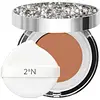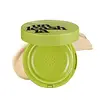What's inside
What's inside
 Key Ingredients
Key Ingredients

 Benefits
Benefits

 Concerns
Concerns

 Ingredients Side-by-side
Ingredients Side-by-side

Water
Skin ConditioningPhenyl Trimethicone
Skin ConditioningIsononyl Isononanoate
EmollientCI 77891
Cosmetic ColorantButylene Glycol
HumectantCyclopentasiloxane
EmollientGlycerin
HumectantPentaerythrityl Tetraethylhexanoate
EmollientMica
Cosmetic ColorantCetyl PEG/PPG-10/1 Dimethicone
EmulsifyingCI 77492
Cosmetic ColorantCaprylic/Capric Triglyceride
MaskingCyclohexasiloxane
Emollient1,2-Hexanediol
Skin ConditioningDisteardimonium Hectorite
StabilisingIsododecane
EmollientBis-PEG/PPG-14/14 Dimethicone
EmollientAcrylates/Polytrimethylsiloxymethacrylate Copolymer
Skin ConditioningMagnesium Sulfate
Stearoyl Inulin
EmollientCI 77491
Cosmetic ColorantGlyceryl Tribehenate/Isostearate/Eicosandioate
EmollientChlorella Vulgaris Extract
Skin ConditioningGlucose
HumectantPolyglyceryl-2 Diisostearate
EmulsifyingCI 77499
Cosmetic ColorantGlyceryl Caprylate
EmollientFructooligosaccharides
HumectantFructose
HumectantTriethoxycaprylylsilane
Aluminum Dimyristate
Emulsion StabilisingAluminum Hydroxide
EmollientDimethicone
EmollientCetearyl Dimethicone/Vinyl Dimethicone Crosspolymer
EmollientEthylhexylglycerin
Skin ConditioningCentella Asiatica Extract
CleansingChamomilla Recutita Flower Extract
MaskingParfum
MaskingTrisodium Ethylenediamine Disuccinate
Ceramide NP
Skin ConditioningPanthenol
Skin ConditioningPentaerythrityl Tetra-Di-T-Butyl Hydroxyhydrocinnamate
AntioxidantCentella Asiatica Leaf Extract
Skin ConditioningWater, Phenyl Trimethicone, Isononyl Isononanoate, CI 77891, Butylene Glycol, Cyclopentasiloxane, Glycerin, Pentaerythrityl Tetraethylhexanoate, Mica, Cetyl PEG/PPG-10/1 Dimethicone, CI 77492, Caprylic/Capric Triglyceride, Cyclohexasiloxane, 1,2-Hexanediol, Disteardimonium Hectorite, Isododecane, Bis-PEG/PPG-14/14 Dimethicone, Acrylates/Polytrimethylsiloxymethacrylate Copolymer, Magnesium Sulfate, Stearoyl Inulin, CI 77491, Glyceryl Tribehenate/Isostearate/Eicosandioate, Chlorella Vulgaris Extract, Glucose, Polyglyceryl-2 Diisostearate, CI 77499, Glyceryl Caprylate, Fructooligosaccharides, Fructose, Triethoxycaprylylsilane, Aluminum Dimyristate, Aluminum Hydroxide, Dimethicone, Cetearyl Dimethicone/Vinyl Dimethicone Crosspolymer, Ethylhexylglycerin, Centella Asiatica Extract, Chamomilla Recutita Flower Extract, Parfum, Trisodium Ethylenediamine Disuccinate, Ceramide NP, Panthenol, Pentaerythrityl Tetra-Di-T-Butyl Hydroxyhydrocinnamate, Centella Asiatica Leaf Extract
Water
Skin ConditioningTitanium Dioxide
Cosmetic ColorantDiphenylsiloxy Phenyl Trimethicone
Skin ConditioningButylene Glycol
HumectantButyloctyl Salicylate
Skin ConditioningEthylhexyl Stearate
EmollientC12-15 Alkyl Benzoate
AntimicrobialCyclopentasiloxane
EmollientGlycerin
HumectantCetyl PEG/PPG-10/1 Dimethicone
EmulsifyingPolyglyceryl-4 Isostearate
EmulsifyingPentaerythrityl Tetraisostearate
EmollientNiacinamide
SmoothingSqualane
EmollientPvp
Emulsion StabilisingCyclohexasiloxane
EmollientDimer Dilinoleyl Dimer Dilinoleate
EmollientDisteardimonium Hectorite
StabilisingMagnesium Sulfate
Trimethylsiloxysilicate
EmollientPolyphenylsilsesquioxane
CI 77492
Cosmetic ColorantTribehenin
EmollientAcrylates/Stearyl Acrylate/Dimethicone Methacrylate Copolymer
Aluminum Hydroxide
EmollientCaprylyl Glycol
EmollientTriethoxycaprylylsilane
Bakuchiol
AntimicrobialCI 77491
Cosmetic ColorantEthylhexylglycerin
Skin ConditioningCI 77499
Cosmetic ColorantAdenosine
Skin Conditioning1,2-Hexanediol
Skin ConditioningCarica Papaya Fruit Water
Skin ConditioningChamomilla Recutita Flower Extract
MaskingPolyglutamic Acid
Skin ConditioningPolymethylsilsesquioxane
Carum Petroselinum Extract
Skin ConditioningWater, Titanium Dioxide, Diphenylsiloxy Phenyl Trimethicone, Butylene Glycol, Butyloctyl Salicylate, Ethylhexyl Stearate, C12-15 Alkyl Benzoate, Cyclopentasiloxane, Glycerin, Cetyl PEG/PPG-10/1 Dimethicone, Polyglyceryl-4 Isostearate, Pentaerythrityl Tetraisostearate, Niacinamide, Squalane, Pvp, Cyclohexasiloxane, Dimer Dilinoleyl Dimer Dilinoleate, Disteardimonium Hectorite, Magnesium Sulfate, Trimethylsiloxysilicate, Polyphenylsilsesquioxane, CI 77492, Tribehenin, Acrylates/Stearyl Acrylate/Dimethicone Methacrylate Copolymer, Aluminum Hydroxide, Caprylyl Glycol, Triethoxycaprylylsilane, Bakuchiol, CI 77491, Ethylhexylglycerin, CI 77499, Adenosine, 1,2-Hexanediol, Carica Papaya Fruit Water, Chamomilla Recutita Flower Extract, Polyglutamic Acid, Polymethylsilsesquioxane, Carum Petroselinum Extract
 Reviews
Reviews

Ingredients Explained
These ingredients are found in both products.
Ingredients higher up in an ingredient list are typically present in a larger amount.
1,2-Hexanediol is a synthetic liquid and another multi-functional powerhouse.
It is a:
- Humectant, drawing moisture into the skin
- Emollient, helping to soften skin
- Solvent, dispersing and stabilizing formulas
- Preservative booster, enhancing the antimicrobial activity of other preservatives
Aluminum Hydroxide is a form of aluminum. It can be naturally found in nature as the mineral gibbsite. In cosmetics, Aluminum Hydroxide is used as a colorant, pH adjuster, and absorbent.
As a colorant, Aluminum Hydroxide may add opacity, or reduce the transparency. Aluminum hydroxide is contains both basic and acidic properties.
According to manufacturers, this ingredient is an emollient and humectant. This means it helps hydrate the skin.
In medicine, this ingredient is used to help relieve heartburn and help heal ulcers.
There is currently no credible scientific evidence linking aluminum hydroxide in cosmetics to increased cancer risk.
Major health organizations allow the use of aluminum hydroxide in personal care products and have not flagged it as a carcinogenic risk at typical usage levels.
Learn more about Aluminum HydroxideButylene Glycol (or BG) is used within cosmetic products for a few different reasons:
Overall, Butylene Glycol is a safe and well-rounded ingredient that works well with other ingredients.
Though this ingredient works well with most skin types, some people with sensitive skin may experience a reaction such as allergic rashes, closed comedones, or itchiness.
Learn more about Butylene GlycolThis ingredient is a high molecular weight silicone. It has emulsifying and skin conditioning properties.
Chamomilla Recutita Flower Extract comes from the Chamomile flower.
Chamomile is rich in antioxidants and has anti-inflammatory properties. Several compounds found in chamomile help with soothing, such as bisbolol.
Antioxidant components in chamomile make it an effective ingredient to help slow the signs of aging. Antioxidants help fight free-radical molecules, or molecules that may damage your skin.
Essential oils from chamomile have been found to improve wound healing due to its antimicrobial properties.
Ancient Greeks and Egyptians used Chamomile to treat skin redness and dryness. Chamomile has also been used to help treat stomach issues.
Learn more about Chamomilla Recutita Flower ExtractCi 77491 is also hydrated iron III oxide. It's sole purpose is to give a red/pink hue to products.
Iron III oxides are classified as inorganic chemicals for coloring.
Synthetically created Ci 77491 is considered safer than those naturally found. This is because the synthetically created version may contain less impurities. Iron oxides are generally non-toxic and non-allergenic.
Learn more about CI 77491Ci 77492 is also hydrated iron III oxide. It's sole purpose is to give a yellow hue to products.
Iron III oxides are classified as inorganic chemicals for coloring.
Synthetically created Ci 77492 is considered safer than those naturally found. This is because the synthetically created version may contain less impurities. Iron oxides are generally non-toxic and non-allergenic.
Learn more about CI 77492Ci 77499 is also hydrated iron III oxide. It is created from mixing red and black iron oxides. This helps give shades of darkness to a product.
Iron III oxides are classified as inorganic chemicals for coloring.
Cyclohexasiloxane is a type of silicone more commonly known as D6. It is an emollient and solvent.
Cyclohexasiloxane is used to evenly distribute ingredients throughout the product. When applied to the skin, Cyclohexasiloxane evaporates and leaves behind a silky feel.
As an emollient, it can help the skin feel soft and hydrated. It is also used to reduce frizz in hair products.
Learn more about CyclohexasiloxaneCyclopentasiloxane, or D5, is a silicone used to improve texture of products and trap moisture.
D5 is considered lightweight and volatile. Volatile means it evaporates quickly after application. Once evaporated, D5 leaves a thin barrier that helps keep skin hydrated.
It is also an emollient. Emollients help soften the skin and prevent water loss. Silicones create a silky texture in products. D5 helps other ingredients become more spreadable.
Studies show D5 is safe to use in skincare products. We recommend speaking with a skincare professional if you have concerns.
Learn more about CyclopentasiloxaneDisteardimonium Hectorite comes from the clay mineral named hectorite. It is used to add thickness to a product.
It can also help stabilize a product by helping to disperse other ingredients.
Hectorite is a rare, white clay mineral.
Learn more about Disteardimonium HectoriteEthylhexylglycerin (we can't pronounce this either) is commonly used as a preservative and skin softener. It is derived from glyceryl.
You might see Ethylhexylglycerin often paired with other preservatives such as phenoxyethanol. Ethylhexylglycerin has been found to increase the effectiveness of these other preservatives.
Glycerin is already naturally found in your skin. It helps moisturize and protect your skin.
A study from 2016 found glycerin to be more effective as a humectant than AHAs and hyaluronic acid.
As a humectant, it helps the skin stay hydrated by pulling moisture to your skin. The low molecular weight of glycerin allows it to pull moisture into the deeper layers of your skin.
Hydrated skin improves your skin barrier; Your skin barrier helps protect against irritants and bacteria.
Glycerin has also been found to have antimicrobial and antiviral properties. Due to these properties, glycerin is often used in wound and burn treatments.
In cosmetics, glycerin is usually derived from plants such as soybean or palm. However, it can also be sourced from animals, such as tallow or animal fat.
This ingredient is organic, colorless, odorless, and non-toxic.
Glycerin is the name for this ingredient in American English. British English uses Glycerol/Glycerine.
Learn more about GlycerinMagnesium Sulfate is a salt. More specifically, it is an epsom salt, or the bath salt used to help relieve muscle aches.
Despite having ‘sulfate’ in the name, it isn’t a surfactant or cleansing agent like sodium lauryl sulfate. Unlike those sulfates, magnesium sulfate doesn’t have the same cleansing or foaming properties (it's simply a type of salt).
In cosmetics, Magnesium Sulfate is used to thicken a product or help dilute other solids. It is a non-reactive and non-irritating ingredient.
One study shows magnesium deficiency may lead to inflammation of the skin. Applying magnesium topically may help reduce inflammation.
You can find this ingredient in sea water or mineral deposits.
Learn more about Magnesium SulfateTriethoxycaprylylsilane is a silicone used to bind and stabilize ingredients.
As an emulsifier, it helps prevent ingredients from separating. This can help elongate the shelf life of products.
Triethoxycaprylylsilane is often used to coat mineral sunscreens ingredients to help give a better feel. It also helps reduce oxidative stress in sunscreens.
Learn more about TriethoxycaprylylsilaneWater. It's the most common cosmetic ingredient of all. You'll usually see it at the top of ingredient lists, meaning that it makes up the largest part of the product.
So why is it so popular? Water most often acts as a solvent - this means that it helps dissolve other ingredients into the formulation.
You'll also recognize water as that liquid we all need to stay alive. If you see this, drink a glass of water. Stay hydrated!
Learn more about Water